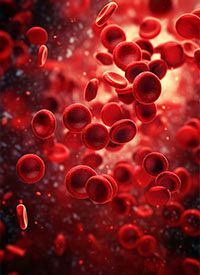News
Article
Crovalimab Earns Approval in Europe for Paroxysmal Nocturnal Hemoglobinuria
The European Commission has approved crovalimab for adult and pediatric patients with paroxysmal nocturnal hemoglobinuria.
EU Approval of Crovalimab in PNH:
© vitanovski - stock.adobe.com

The European Commission has approved crovalimab-akkz (Piasky) for the treatment of adult and pediatric patients 12 years of age or older with a body weight of at least 40 kg with paroxysmal nocturnal hemoglobinuria (PNH). The agent is indicated for patients who are naive to or have been previously treated with C5 inhibitors.1
The approval was supported by data from the phase 3 COMMODORE 2 trial (NCT04434092), which showed that crovalimab was noninferior to eculizumab (Soliris) regarding the study’s co-primary end points in patients with PNH who were not previously exposed to a C5 inhibitor. Findings showed that 79.3% of patients treated with crovalimab (n = 134) achieved hemolysis control from week 5 to week 25 vs 79.0% of those given eculizumab (n = 69; odds ratio, 1.0; 95% CI, 0.6-1.8).2 Additionally, 65.7% of patients in the crovalimab arm experienced transfusion avoidance compared with 68.1% of patients in the eculizumab arm.
The regulatory decision was also based on supportive data from the phase 3 COMMODORE 1 trial (NCT04432584), which evaluated patients who switched from previously approved C5 inhibitors to crovalimab, and the phase 3 COMMODORE 3 trial (NCT04654468), which investigated the agent in patients with PNH from China who were naive to C5 inhibitors.1
“[Patients] with PNH are often burdened with life-long, frequent intravenous infusions with time-consuming clinic visits, meaning that their lives, as well as their caregivers’ and families’ lives, may revolve around the demands of their treatment,” Alexander Röth, MD, head of Classical Hematology and Hemostasis at the West German Cancer Centre, University Hospital Essen, stated in a news release.1 “More flexible treatment options such as [crovalimab], which are just as effective but less frequent and can be given more quickly at home, are essential to give [patients] with PNH greater control over their treatment and more independence.”
In June 2024, the FDA approved crovalimab for the treatment of adult and pediatric patients 13 years of age and older with PNH and a body weight of at least 40 kg, based on data from COMMODORE 2.3
COMMODORE 2 was a randomized, open-label, active-controlled trial that enrolled adult and pediatric patients who weighed at least 40 kg at screening. Patients needed to have documented PNH confirmed by high sensitivity flow cytometry evaluation with a granulocyte and/or monocyte clone size of at least 10%. Significant disease activity, defined as a lactate dehydrogenase (LDH) level at least 2 times the upper limit of normal (ULN) and the presence of one or more PNH-related signs or symptoms in the previous 3 months, was required at screening. Patients were required to be vaccinated for Neisseria meningitidis serotypes A, C, W, and Y within 3 years of study treatment. The trial excluded patients who were currently receiving or previously received a C5 inhibitor.2
Patients at least 18 years of age were randomly assigned 2:1 to receive crovalimab or eculizumab (Soliris). Crovalimab was administered at 1000 mg to patients with a body weight of less than 100 kg or at 1500 mg to those weighing at least 100 kg. It was then given as subcutaneous doses of 340 mg on days 2, 8, 15, and 22. Maintenance crovalimab was administered at 680 mg or 1020 mg to patients who weighed less than 100 kg or at least 100 kg, respectively, once every 4 weeks starting day 29. Patients in the randomized arm were stratified by LDH value (≥2 to ≤4 × ULN vs >4 × ULN) and transfusion history in the prior 6 months (0 vs >0 to ≤6 vs >6 red blood cell units).
Those under 18 years of age were enrolled to a nonrandomized arm, and all received crovalimab.
Along with the co-primary end points of hemolysis control from week 5 to week 25 and transfusion avoidance from baseline to week 25, secondary end points included breakthrough hemolysis from baseline to week 25, stabilized hemoglobin from baseline to week 25, and mean change in fatigue in adult patients from baseline to week 25.
Additional data showed that crovalimab was noninferior to eculizumab in regard to the rates of breakthrough hemolysis (10.4% vs 14.5%) and hemoglobin stabilization (63.4% vs 60.9%).
Regarding safety, the rate of any-grade, all-cause adverse effects (AEs) was 77.8% for patients treated with crovalimab (n = 135) vs 79.7% for those given eculizumab (n = 69). Any-grade AEs reported in at least 10% of patients in either arm included infusion-related reactions (crovalimab, 15.6%; eculizumab, 13.0%), decreased neutrophil count (12.6%; 10.1%), decreased white blood cell count (11.9%; 10.1%), hypokalemia (11.0%; 13.0%), pyrexia (8.9%; 10.1%), upper respiratory tract infection (8.1%; 13.0%), and hypocalcemia (5.9%; 10.1%).
The rates of any-grade treatment-related AEs were 33.3% for crovalimab vs 34.8% for eculizumab. The rates of grade 3 to 5 AEs were 17.8% and 24.6%, respectively. AEs led to death in 2 patients (1.5%) in the crovalimab arm vs 1 patients (1.4%) in the eculizumab arm.
Serious AEs occurred in 10.4% of patients treated with crovalimab vs 13.0% of patients given eculizumab. In the experimental arm, AEs led to dose modification and treatment discontinuation in 3.7% and 0.7% of patients, respectively. Those respective rates were 4.3% and 1.4% for the control arm.
References
- Roche’s PiaSky approved in the EU as the first monthly subcutaneous treatment for people with PNH. News release. Roche. August 27, 2024. Accessed August 27, 2024. https://www.roche.com/media/releases/med-cor-2024-08-27
- Röth A, He G, Tong H, et al. Phase 3 randomized COMMODORE 2 trial: Crovalimab versus eculizumab in patients with paroxysmal nocturnal hemoglobinuria naive to complement inhibition. Am J Hematol. 2024;99(9):1768-1777. doi:10.1002/ajh.27412
- Piasky. Prescribing information. June 2024. Accessed August 27, 2024. https://www.accessdata.fda.gov/drugsatfda_docs/label/2024/761388s000lbl.pdf









